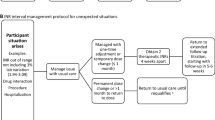Abstract
Historically, there has been limited data informing practical matters encountered in day-to-day warfarin management. Several studies have recently explored topics that address several of these gaps in the literature. Extending INR recheck intervals to 12 weeks is feasible with comparable time-in-therapeutic range compared to traditional 4 week intervals. Patients more likely to maintain stable anticoagulation are older, have an INR target of 2–3 (versus higher targets), and do not have heart failure. Unsurprisingly, non-adherence with reliably taking warfarin is associated with poor anticoagulation control. In addition, non-adherence with INR monitoring is associated with an increased risk of thromboembolism. Evidence-based interventions to improve adherence are lacking. When managing a modestly out of range INR value in previously stable warfarin patients, providers have a few options: 1) change the maintenance warfarin dose, 2) give a one-time dose adjustment, followed by resumption of the previous warfarin dose, or 3) continue the same warfarin dose with no adjustment. Each of these options can be successful, particularly when paired with increased INR monitoring. Bridging with low-molecular-weight heparin for a single subtherapeutic INR is not warranted for most patients. The 9th edition of the American College of Chest Physicians Evidence-Based Clinical Practice Guidelines for Antithrombotic Therapy and Prevention of Thrombosis chapter “Evidence-Based Management of Anticoagulant Therapy” reviews these and many new and practical recommendations for anticoagulation clinic providers.

Similar content being viewed by others
References
Holbrook A, Schulman S, Witt DM, Vandvik PO, Fish J, Kovacs MJ, Svensson PJ, Veenstra DL, Crowther M, Guyatt GH, American College of Chest Physicians (2012) Evidence-based management of anticoagulant therapy: antithrombotic therapy and prevention of thrombosis, 9th ed: American College of Chest Physicians Evidence-Based Clinical Practice Guidelines. Chest 141(2Suppl):e152S–e184S
Fitzmaurice DA (2008) Oral anticoagulation should be managed in the community with treatment aimed at standard therapeutic targets and increased recall intervals. J Thromb Haemost 6(10):1645–1646
Schulman S, Parpia S, Stewart C, Rudd-Scott L, Julian JA, Levine M (2011) Warfarin dose assessment every 4 weeks versus every 12 weeks in patients with stable international normalized ratios: a randomized trial. Ann Intern Med 155(10):653–659
Witt DM, Delate T, Clark NP, Martell C, Tran T, Crowther MA, Garcia DA, Ageno W, Hylek EM, Warped Consortium (2010) Twelve-month outcomes and predictors of very stable INR control in prevalent warfarin users. J Thromb Haemost 8(4):744–749
Witt DM, Delate T, Clark NP, Martell C, Tran T, Crowther MA, Garcia DA, Ageno W, Hylek EM, Warfarin Associated Research Projects and other EnDeavors (WARPED) Consortium (2009) Outcomes and predictors of very stable INR control during chronic anticoagulation therapy. Blood 114(5):952–956
Parker CS, Chen Z, Price M, Gross R, Metlay JP, Christie JD, Brensinger CM, Newcomb CW, Samaha FF, Kimmel SE (2007) Adherence to warfarin assessed by electronic pill caps, clinician assessment, and patient reports: results from the IN-RANGE study. J Gen Intern Med 22(9):1254–1259
Orensky IA, Holdford DA (2005) Predictors of noncompliance with warfarin therapy in an outpatient anticoagulation clinic. Pharmacotherapy 25(12):1801–1808
Davis NJ, Billett HH, Cohen HW, Arnsten JH (2005) Impact of adherence, knowledge, and quality of life on anticoagulation control. Ann Pharmacother 39(4):632–636
Kimmel SE, Troxel AB, Loewenstein G, Brensinger CM, Jaskowiak J, Doshi JA, Laskin M, Volpp K (2012) Randomized trial of lottery-based incentives to improve warfarin adherence. Am Heart J 164(2):268–274
Witt D, Delate T, Clark N, Garcia D, Hylek E (2012) Nonadherence with INR monitoring and anticoagulant complications. Poster presented at The American Society of Health Systems Pharmacy Summer Meeting, Baltimore 9–13 June 2012
Rose AJ, Ozonoff A, Berlowitz DR, Ash AS, Reisman JI, Hylek EM (2011) Reexamining the recommended follow-up interval after obtaining an in-range international normalized ratio value: results from the Veterans Affairs study to improve anticoagulation. Chest 140(2):359–365
Schulman S, Melinyshyn A, Ennis D, Rudd-Scott L (2010) Single-dose adjustment versus no adjustment of warfarin in stably anticoagulated patients with an occasional international normalized ratio (INR) out of range. Thromb Res 125(5):393–397
Banet GA, Waterman AD, Milligan PE, Gatchel SK, Gage BF (2003) Warfarin dose reduction vs watchful waiting for mild elevations in the international normalized ratio. Chest 123(2):499–503
Clark NP, Witt DM, Delate T, Trapp M, Garcia D, Ageno W, Hylek EM, Crowther MA, Warfarin-Associated Research Projects and Other Endeavors Consortium (2008) Thromboembolic consequences of subtherapeutic anticoagulation in patients stabilized on warfarin therapy: the low INR study. Pharmacotherapy 28(8):960–967
Dentali F, Riva N, Malato A, Saccullo G, Siragusa S, Ageno W (2009) Incidence of thromboembolic complications in patients with mechanical heart valves with a subtherapeutic international normalized ratio. J Thorac Cardiovasc Surg 137(1):91–93
Dentali F, Pignatelli P, Malato A, Poli D, Di Minno MN, Di Gennaro L, Rancan E, Pastori D, Grifoni E, Squizzato A, Siragusa S, Di Minno G, Ageno W (2012) Incidence of thromboembolic complications in patients with atrial fibrillation or mechanical heart valves with a subtherapeutic international normalized ratio: a prospective multicenter cohort study. Am J Hematol 87(4):384–387
Author information
Authors and Affiliations
Corresponding author
Rights and permissions
About this article
Cite this article
Clark, N.P. Frequency of monitoring, non-adherence, and other topics dear to an anticoagulation clinic provider. J Thromb Thrombolysis 35, 320–324 (2013). https://doi.org/10.1007/s11239-013-0887-y
Published:
Issue Date:
DOI: https://doi.org/10.1007/s11239-013-0887-y




